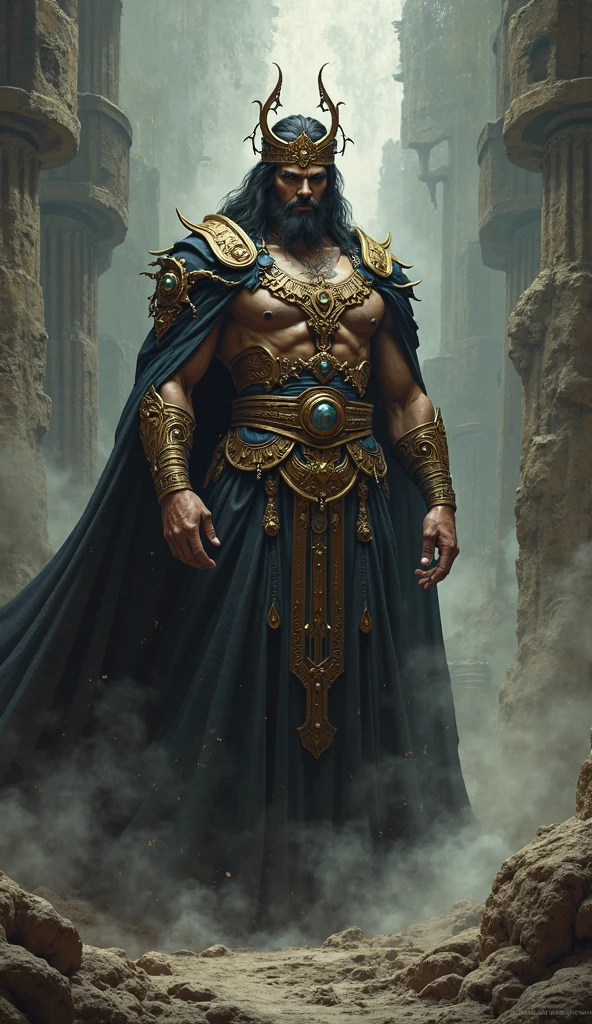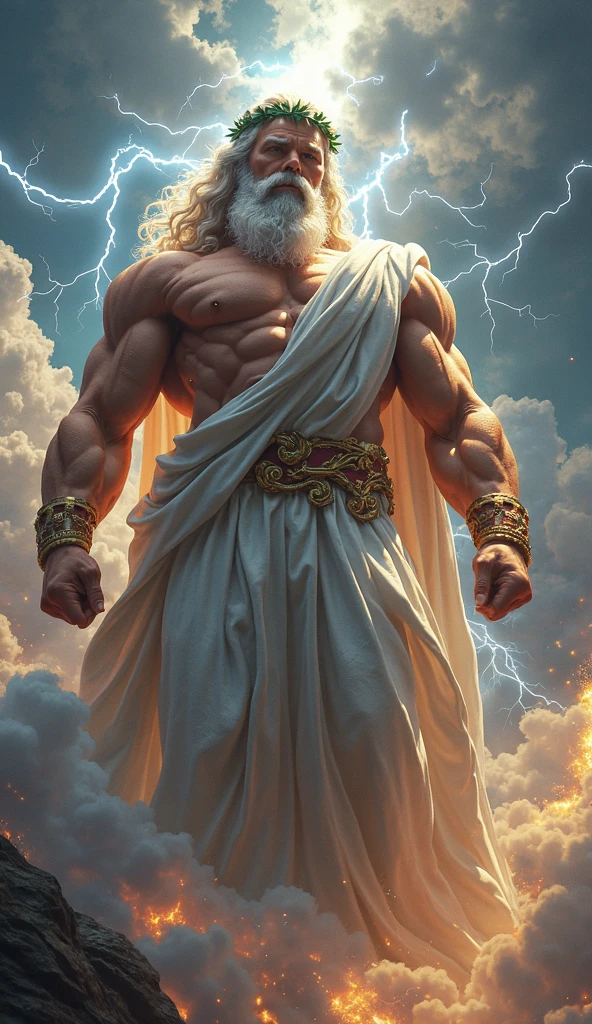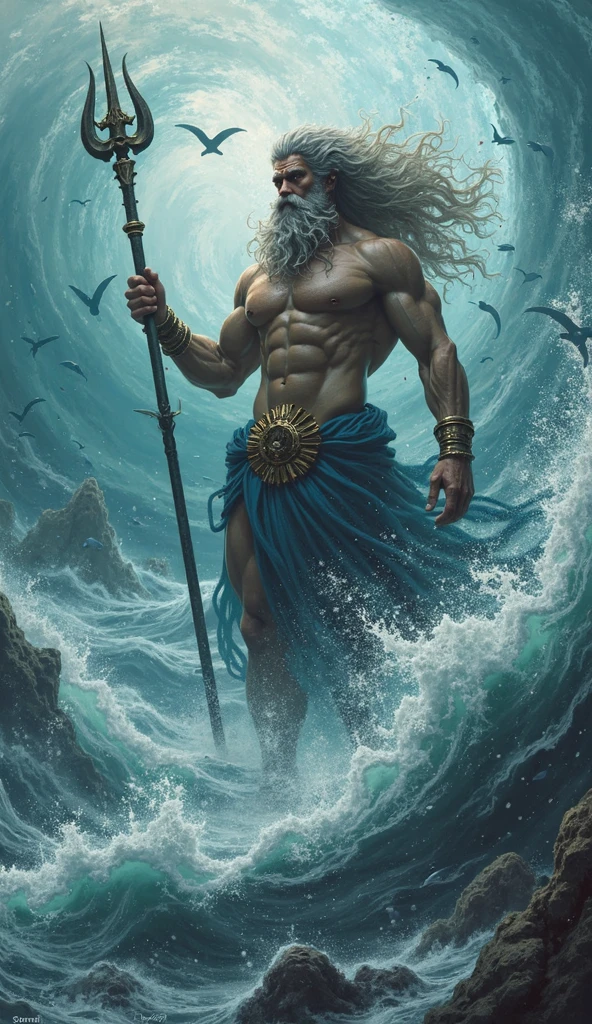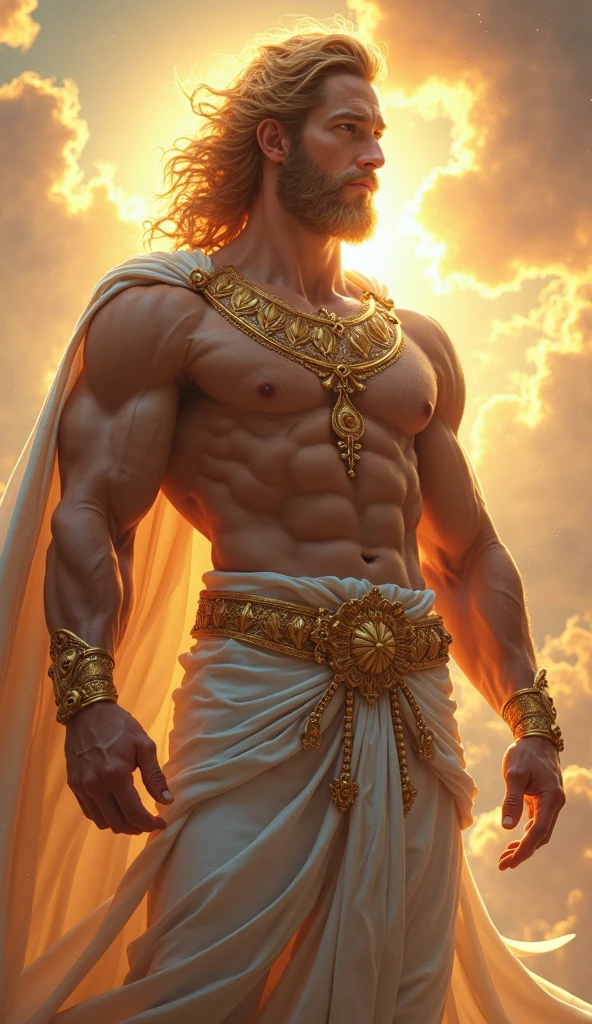Leigong Thunder God Punishes Mortals With Lightning
In Chinese mythology, Leigong is the fearsome god of thunder, wielding lightning as his divine weapon to enforce justice. Known as the Thunder God, he strikes down evildoers and maintains cosmic order during violent storms. This article explores his origins, powers, and cultural significance.
The Origins of Leigong
Leigong (雷公) translates to “Thunder Duke” or “Thunder Lord.” He is part of a celestial bureaucracy in Taoist tradition, often depicted alongside Dianmu, the Lightning Goddess. According to legend, he was once a mortal named Wen Zhong, who ascended to divinity after demonstrating unwavering righteousness.
- Symbolism: Represents divine retribution and natural forces.
- Appearance: Often shown with a drum, mallet, or chisel to summon thunder.
- Role: Punishes oath-breakers, corrupt officials, and immoral beings.
Leigong in Ancient Texts
References to Leigong appear in classical texts like Fengshen Yanyi (“Investiture of the Gods”), where he aids Jiang Ziya in overthrowing tyranny. His interventions are sudden and deadly—embodying the unpredictability of storms.
| Text | Description of Leigong |
|---|---|
| Fengshen Yanyi | Divine enforcer of cosmic justice |
| Shan Hai Jing | Linked to weather phenomena |
| Taoist Canon | Part of the celestial ministry |
Leigong’s Powers and Divine Justice
Leigong does not act alone. He commands a retinue of assistants, including:
- Dianmu (闪电娘娘): Controls lightning bolts.
- Yun Tong (云童): The cloud herald.
- Yu Shi (雨师): The rain master.
Together, they unleash thunder and torrential rains to cleanse the world of wickedness. Folktales warn that those struck by Leigong‘s lightning face public humiliation or instant death—a stark reminder of divine justice.
Modern Interpretations
Today, Leigong remains a popular figure in media, from video games like Smite to TV dramas. His imagery is also used in festivals to ward off misfortune. For deeper insights, explore Britannica’s entry on Chinese deities.
Rituals and Worship of Leigong
Devotees seek Leigong‘s protection by offering incense and prayers during thunderstorms. Key rituals include:
- Lighting red candles to symbolize his fiery power.
- Chanting sutras to appease his wrath.
- Avoiding loud noises during storms to prevent his anger.
Temples dedicated to Leigong, like the one in Guangdong, feature statues of him mid-strike—a dramatic representation of his role as a punisher. For travel tips, visit Travel China Guide.
Comparative Mythology: Leigong vs. Other Thunder Gods
| Deity | Culture | Similarities |
|---|---|---|
| Leigong | Chinese | Uses lightning for justice |
| Thor | Norse | Wields a hammer (Mjölnir) |
| Indra | Hindu | God of rain and storms |
Discover more mythological tales and updates by following us on facebook.com/zatiandrops.
The Symbolic Weapons of Leigong
Unlike other thunder deities who rely on a single weapon, Leigong employs multiple tools to execute divine justice. His arsenal includes:
- The Thunder Drum (雷鼓): Used to create deafening booms that shake the heavens.
- The Lightning Chisel (雷凿): A tool believed to carve lightning bolts from the sky.
- The Wind Bag (风袋): Contains tempests that amplify storm intensity.
These instruments highlight his role as a cosmic enforcer, blending raw power with precision. Historical texts describe how he calibrates their use—gentler strikes for minor transgressions, cataclysmic ones for grave sins.
Leigong’s Relationship with Dianmu
While Leigong controls thunder, his counterpart Dianmu (闪电娘娘) manipulates lightning. Their partnership is often depicted as a celestial marriage:
| Aspect | Leigong | Dianmu |
|---|---|---|
| Domain | Thunder | Lightning |
| Weapon | Drum/Chisel | Mirror (reflects bolts) |
| Symbolism | Audible power | Visible judgment |
Folklore suggests their synchronized strikes represent yin-yang balance—Leigong’s thunder (masculine energy) and Dianmu’s lightning (feminine energy) merging to restore harmony.
Leigong’s Role in Agricultural Traditions
Beyond punishment, Leigong is invoked for agricultural prosperity. Farmers historically performed rituals to:
- Request timely rains during droughts.
- Prevent crop damage from hailstorms.
- Bless seeds before planting seasons.
Villages along the Yangtze River still celebrate the Thunder God Festival in spring, offering first harvests to ensure his favor. This duality—destroyer and benefactor—makes him uniquely revered.
Meteorological Phenomena Attributed to Leigong
Ancient Chinese scholars documented weather events tied to Leigong’s moods:
- Ball Lightning: Interpreted as his “testing strikes” on hidden evils.
- Dry Thunderstorms: Seen as warnings to corrupt leaders.
- Thunder Snow: Rare events believed to signal celestial audits.
Leigong in Martial Arts and Folklore
Several kung fu styles emulate Leigong’s explosive movements. The “Thunder Fist” (雷拳) technique, for example, mimics his abrupt strikes. Legends also tell of warriors gifted supernatural speed after surviving lightning attacks—a nod to his selective mercy.
Notable Tales of Divine Retribution
Oral traditions preserve stories of Leigong’s interventions:
| Story | Moral Lesson |
|---|---|
| The Merchant Who Cheated Widows | Struck mid-swindle; coins fused to his hands |
| The Official Who Burned Tax Records | Lightning ignited only his corrupt documents |
| The Monk Who Broke Vows | Thunderclap left him unharmed but mute |
Leigong’s Influence on Chinese Architecture
To deter Leigong’s wrath, traditional buildings incorporated protective designs:
- Lightning Rods (避雷针): Early versions used iron spikes shaped like his chisel.
- Roof Guardians (吻兽): Dragon statues believed to absorb stray bolts.
- Courtyard Mirrors (照壁): Placed opposite gates to “reflect away” divine scrutiny.
Regional Variations of Leigong Worship
Local adaptations reveal cultural nuances:
| Region | Unique Practice |
|---|---|
| Fujian | Operas performed during storms to entertain him |
| Sichuan | Chili peppers offered to “match his fiery temper” |
| Manchuria | Shamans wear blue robes to symbolize his storm clouds |
Leigong’s Presence in Contemporary Culture
Modern adaptations keep Leigong relevant:
- Anime/Manga: Appears in Journey to the West adaptations as a comic relief character.
- Literature: Featured in Neil Gaiman’s Sandman as part of the “Chinese Pantheon.”
- Music: Taiwanese metal band Chthonic’s album Takasago Army references his myths.
Scientific Parallels to Leigong’s Powers
Interestingly, Leigong’s described abilities align with modern meteorology:
- Thunder: Caused by rapid air expansion (his drumbeats).
- Lightning: Electrical discharges (Dianmu’s mirror reflections).
- Hail: Formed in updrafts (his wind bag’s tempests).
Discover more mythological tales and updates by following us on facebook.com/zatiandrops.
The Thunder God’s Role in Legal Traditions
In imperial China, Leigong was invoked during court trials as a supernatural witness. Judges would threaten perjurers with his wrath, believing false oaths attracted lightning strikes. Historical records from the Ming Dynasty describe cases where sudden storms halted proceedings—interpreted as Leigong’s intervention.
Legal Punishments Inspired by Leigong
| Crime | Divine Punishment | Earthly Equivalent |
|---|---|---|
| Perjury | Lightning-scorched tongue | Branding with hot iron |
| Tax Evasion | Struck holding stolen coins | Public flogging |
| Blasphemy | Deafening thunderclaps | Exile to remote regions |
Leigong’s Connection to Chinese Medicine
Traditional healers associated thunderstorms with physiological effects. The Huangdi Neijing medical text prescribes:
- Acupuncture: Needles called “lightning needles” (雷针) for sudden pain relief.
- Herbal Remedies: Storms were believed to enhance potency of mountain herbs.
- Diagnostics: Patients struck by lightning (and surviving) were studied for immunity clues.
Thunder-Related Ailments and Cures
Medieval physicians cataloged unique conditions:
- Thunder Headache (雷头痛): Treated with magnetite powder to “ground” the pain.
- Lightning Tremors (闪电颤): Massages using jade rollers.
- Storm Anxiety (风暴惊): Meditation near bronze temple bells.
Leigong’s Influence on Chinese Warfare
Military strategists studied Leigong’s tactics for inspiration:
- Shock and Awe: Drummers mimicked thunder patterns to disorient enemies.
- Flanking Maneuvers: Called “lightning wings” (闪电翼) for rapid encirclement.
- Siege Weapons: Catapults named “cloud chisels” after his tools.
Famous Battles Linked to Thunder Omens
| Battle | Omen | Outcome |
|---|---|---|
| Red Cliffs (208 CE) | Pre-storm calm | Fire attack succeeded |
| Talas River (751 CE) | Dry lightning | Tang Dynasty defeat |
| Yamen (1279 CE) | Thunder snow | Song Dynasty collapse |
Leigong’s Animal Associations
Certain creatures were considered avatars or messengers of the Thunder God:
- Golden Cicadas: Their sudden emergence after storms symbolized rebirth.
- Azure Dragons: Cloud-controllers who assisted his weather commands.
- Black-Footed Ferrets: Folk belief held they could predict lightning strikes.
Taboo Animals in Leigong Worship
These animals were avoided during rituals:
- Owls: Their nocturnal nature opposed his yang energy.
- Turtles: Slow movement contrasted with thunder’s speed.
- White Snakes: Associated with water spirits who rivaled his authority.
Leigong’s Celestial Bureaucracy
As a Taoist deity, Leigong answers to higher authorities in the heavenly hierarchy:
| Rank | Deity | Oversees |
|---|---|---|
| 1st | Jade Emperor | Cosmic order |
| 2nd | Heavenly Ministers | Elemental forces |
| 3rd | Leigong | Thunder/Justice |
Paper Offerings to Leigong
Devotees burn specific joss papers:
- Gold Thunder Paper (雷金纸): For forgiveness of minor sins.
- Storm Horse Cutouts (风马): To speed up his divine responses.
- Lightning Bolt Patterns (闪电纹): Wards off misfortune.
Discover more mythological tales and updates by following us on facebook.com/zatiandrops.
Leigong’s Influence on Chinese Poetry and Literature
The Thunder God has inspired countless poets and scholars throughout Chinese history. His unpredictable nature and divine justice became metaphors in classical verses, often symbolizing sudden enlightenment or societal upheaval. Tang Dynasty poet Li Bai famously wrote: “Leigong’s drum shakes the corrupt from their slumber—a single strike reveals truth.”
Literary Themes Associated with Leigong
- Divine Retribution: Used in morality tales to warn against greed.
- Natural Power: Contrasted with human fragility in landscape poetry.
- Cosmic Balance: Appears in Taoist texts as a force maintaining harmony.
Leigong’s Role in Seasonal Festivals
Beyond the Thunder God Festival, Leigong is honored during:
- Dragon Boat Festival: Thunder rituals protect against evil spirits.
- Mid-Autumn Festival: Mooncakes shaped like his drum symbolize protection.
- Qingming Festival: Ancestors are asked to intercede with Leigong for mild weather.
Regional Festival Variations
| Region | Festival Name | Unique Ritual |
|---|---|---|
| Zhejiang | Thunder Awakening | Flying kites with thunder symbols |
| Yunnan | Lightning Banquet | Communal meals during storms |
| Guangxi | Drum Echo Ceremony | Mimicking thunder with bronze drums |
Leigong’s Symbolism in Chinese Art
Artists depict Leigong using specific visual codes:
- Color Symbolism: Azure skin represents storm clouds, red accents denote lightning.
- Dynamic Poses: Always shown mid-action, emphasizing his relentless nature.
- Architectural Frames: Temple murals often place him above doorways as a protector.
Famous Artworks Featuring Leigong
| Artwork | Period | Location |
|---|---|---|
| “Threw Strikes the Mountain” | Ming Dynasty | Palace Museum, Beijing |
| “Dianmu and Leigong” silk scroll | Qing Dynasty | Shanghai Museum |
| Modern statue at Leifeng Pagoda | 2002 CE | Hangzhou |
Leigong’s Connection to Chinese Astronomy
Ancient astronomers named celestial phenomena after the Thunder God:
- Lei Xiu (雷宿): A constellation representing his celestial palace.
- Thunder Comets: Streaking meteors believed to be his discarded chisels.
- Lightning Stars: Binary star systems that “flicker” like Dianmu’s mirror.
Meteorological Records and Leigong
The Yuán Shǐ historical texts document:
- 1320 CE: A “thunder snow” event interpreted as Leigong judging Mongol rulers.
- 1584 CE: Ball lightning entered a courthouse—seen as divine scrutiny of a corrupt trial.
- 1765 CE: Hailstones shaped like drums fell in Anhui, triggering mass prayers.
Leigong’s Presence in Chinese Naming Conventions
The Thunder God’s influence extends to personal and place names:
| Type | Example | Meaning |
|---|---|---|
| Given Names | Lei (雷) | Invokes strength and justice |
| Place Names | Leiyang City (耒阳) | “Where thunder nourishes” |
| Businesses | Leigong Brewery | Claims “heavenly fired” fermentation |
Taboo Names and Thunder
Certain naming practices are avoided:
- Never combining “Lei” (雷) with “Po” (破, break)—seen as challenging the god.
- Avoiding “Silent Thunder” (默雷) names—considered ominous.
- Mountains with frequent lightning strikes often lack “Lei” names to avoid provocation.
Leigong’s Role in Chinese Divination
Oracle bones and I Ching hexagrams reference thunder omens:
- Zhen (震) Hexagram: Represents awakening and decisive action—linked to Leigong’s strikes.
- Thunder Divination: Counting seconds between lightning and thunder to predict outcomes.
- Dream Interpretation: Being struck by lightning in dreams signals impending life changes.
Historical Divination Records
| Dynasty | Divination Method | Outcome |
|---|---|---|
| Shang | Cracked turtle shells during storms | Predicted military victories |
| Han | Observing lightning tree scars | Foretold drought locations |
| Song | Direction of thunder echoes | Revealed corrupt officials |
Discover more mythological tales and updates by following us on facebook.com/zatiandrops.
Leigong’s Influence on Chinese Architecture
Beyond protective designs, Leigong inspired structural innovations. The dougong bracket system in traditional roofs—interlocking wooden beams—symbolizes his cosmic order, dispersing weight like lightning disperses energy. Key architectural elements include:
- Upturned Eaves: Designed to “deflect” divine strikes skyward.
- Thunder Pattern Tiles (雷纹瓦): Glazed with zigzag motifs to honor him.
- Nine-Ridge Roofs: Reserved for temples, representing his nine thunder forms.
Notable Thunder God Temples
| Temple | Location | Unique Feature |
|---|---|---|
| Leigongshan Temple | Guizhou | Built atop a lightning-struck boulder |
| Dianmu-Leigong Shrine | Fujian | Copper roof conducts/absorbs storms |
| Thunder Altar of Beijing | Imperial City | Qing emperors performed rain rituals here |
Leigong’s Role in Chinese Music
The Thunder God’s percussive power shaped musical traditions:
- Thunder Drums (雷鼓乐): Ceremonial ensembles using buffalo-hide drums to mimic storms.
- Opera Cymbals: Called “lightning plates” (闪电钹) for their crashing tones.
- Daoist Ritual Music: Includes the Leigong Jing (“Thunder Scripture”) chant.
Instruments Linked to Leigong
| Instrument | Material | Symbolism |
|---|---|---|
| Bronze Bianzhong Bells | Tin-copper alloy | Their resonance wards off evil |
| Lei Qin (Thunder Zither) | Paulownia wood | Played during drought ceremonies |
| Storm Flute (风雷笛) | Bamboo with iron fittings | High-pitched notes “pierce clouds” |
Leigong’s Connection to Chinese Alchemy
Taoist alchemists revered Leigong for transformative energy. His lightning was considered the ultimate primal yang force, used metaphorically in:
- Elixir Recipes: “Thunderbolt Pills” contained fulgurite (fused sand from lightning strikes).
- Furnace Designs: Smelting bellows were called “wind bags” after his tool.
- Meditation Techniques: Visualizing inner lightning to purge spiritual blockages.
Alchemical Processes Named After Leigong
- Thunder Refining (雷炼): Rapid heating/cooling to purify metals.
- Lightning Sealing (闪电封): Using electricity-like energy flows in elixirs.
- Cloud-Steaming (云蒸): Creating medicinal vapors during thunderstorms.
Leigong’s Impact on Chinese Linguistics
The Thunder God’s legacy echoes in modern Mandarin:
| Term | Literal Meaning | Usage |
|---|---|---|
| 雷厉风行 (léi lì fēng xíng) | “Thunder swift, wind fast” | Describes decisive action |
| 雷霆万钧 (léi tíng wàn jūn) | “10,000 thunderbolts” | Overwhelming force |
| 雷打不动 (léi dǎ bù dòng) | “Unmoved by thunder” | Unyielding resolve |
Thunder Onomatopoeia in Dialects
- Northern Mandarin: “Hōnglōng” (轰隆) for distant thunder.
- Cantonese: “Lèihlèih” (雷雷) imitates rolling thunder.
- Min Nan: “Lûi-tân” (雷弹) likens thunder to explosions.
Leigong’s Role in Chinese Environmental Philosophy
Traditional ecology viewed Leigong as a natural regulator:
- Forest Fires: Seen as his “purification” of overgrown areas.
- River Course Changes: Attributed to his lightning altering landscapes.
- Species Balance: Folk tales claim he strikes invasive creatures.
Ancient Environmental Practices
- Planting lightning-struck trees as shrine markers.
- Leaving storm-downed timber untouched for 3 days (his “claiming period”).
- Burying hailstones at crossroads to prevent repeat storms.
Leigong’s Presence in Children’s Education
Moral instruction leveraged Leigong’s fearsome reputation:
| Teaching Tool | Lesson |
|---|---|
| “Leigong’s Wrath” shadow puppets | Consequences of lying |
| Thunder-themed tongue twisters | Respect for nature’s power |
| Counting thunderclaps games | Mathematics through storms |
Traditional Nursery Rhymes
- “When Leigong drums his cloudy beat, naughty children lose their sweets.”
- “Dianmu’s mirror flashes bright, showing who did wrong last night.”
- “Nine thunder strikes, nine times right—cheaters tremble in daylight.”
Discover more mythological tales and updates by following us on facebook.com/zatiandrops.



